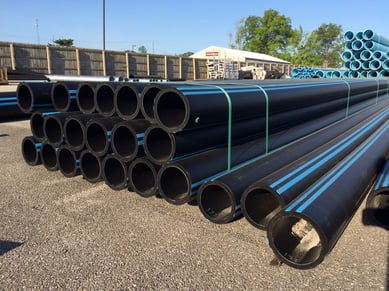Need Water Infrastructure Rehab? Heat Welded HDPE is Your Solution
- Home
- Team EJP Blog
- Need Water Infrastructure Rehab? Heat Welded HDPE is Your Solution
- Jun 22, 2017 7:00:00 AM
- Everett J. Prescott
In upstate New York, the town my husband grew up in had water lines passing under a nearby river. The old pipes had developed leaks over the years, and as the river would reach an algae bloom stage each summer, the river water that leaked into the pipes made the water taste horrible. It was so bad, you could taste it through the syrup in fountain drinks or in the ice used to cool the bottled water that was sold in restaurants. Though this situation wasn't of the level of the recent Flint lead crisis, there's no doubt that the local water utility received many a complaint about the situation. One solution that would have worked well in both situations? Heat fused HDPE.

High-density polyethylene, or HDPE, is a plastic commonly used in pipes to provide a better option for infrastructure rehabilitation. For many years, water has been considered a cheap and plentiful resource. If water pipes were leaking on the way to the customer, it probably wasn't that big of an issue. But with a growing population in our country and world, the spread of industrialization and mounting environmental pressures, that mindset is being laid to rest.
With the recent nationwide drought increasing water demand even as the aquifer levels fell, water utilities realized they were losing billions of dollars every year as they pumped water that never made it to a meter. The 2008 economic recession lead to lower tax revenues for municipalities and government agencies across the country and around the world. This meant that certain economies needed to be implemented.

In Flint, Michigan, this meant changing the water source - a decision that impacted nearly 10,000 children under the age of six who were tested for lead following the crisis, leading to lawsuits against the city and water utility. As water utilities across the country felt the shockwaves of this crisis, one of the constant questions being asked by customers was, "Is our water safe to drink?" While the country continues recovering from the recession, water utilities are scrambling for a better way to improve both water line integrity as well as overall water safety.
One option that has become very popular is using heat-welded HDPE to rehabilitate old water and sewer lines. In traditional lines, the weak point in the pipe is the joint. HDPE doesn't have any joints. In fact, the ends of the pipe are heated and forced together, creating a union that is stronger than the pipe itself. It also doesn't corrode, which was the critical factor in the Flint crisis.
But why rehab sewer lines? The EPA recently reported to Congress that within seven years, without further intervention and rehabilitation in the area of $181 billion, water will reach the level of sewage pollution that was seen in 1968, the highest it's ever been in the U.S. Combine that with the significant heavier load of prescription medications that show up in sewage, and we could be facing the worst clean water crisis in the history of our country.
By using HDPE to rehab your aging supply and sewer lines, you can quickly turn your water utility around by spending less money pumping water that won't make it to the consumer, securing the best possible safety and improving overall line integrity. If you need help finding the right solution for your water utility, please feel free to contact the experts at Team EJP today for more details.








